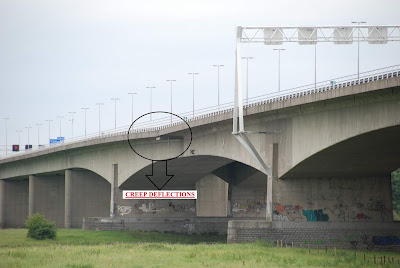Concrete creep is defined as the deformation of concrete structure under sustained load. Basically, long term pressure on stress on concrete can make it change shape. This deformation usually occurs in the direction the force is being applied. When the continuous load is removed, the strain is decreased immediately. The amount of the decreased strain is equal to the elastic strain at the given age. This quick recovery is then followed by a continuous decrease in strain, known as creep recovery that is a part of total creep strain suffered by the concrete.
Creep Coefficient:
The ratio of the ultimate creep strain to the elastic strain at the age of loading is termed as creep coefficient. The assumed data of creep coefficient are given below:
|
Age of
Loading
|
Creep
Coefficient
|
|
7 days
|
2.2
|
|
28 days
|
1.6
|
|
1 year
|
1.1
|
1. Aggregate: The creep in aggregate is very less. It is the paste which is responsible for the creep. However, the aggregate influences the creep of concrete through a restraining effect on the magnitude of creep. The paste which is creeping under load is restrained by aggregate which do not creep. The stronger the aggregate, the more is the restraining effect and hence the less is the magnitude of creep.
2. Mix Proportions: The amount of paste content and its quality is one of the most important factors influencing creep. A paste structure which is poorer undergoes higher creep. Therefore, it can be said that creep increases with increase in water/cement ratio. In other words, it can also be said that creep is inversely proportional to the strength of concrete.
3. Age: It has been observed that for a given type of concrete, the creep decreases as the age at the time of application of load increases as the strength increases with age.
 |
| Figure 2. Variation of creep with age |
5. Degree of Hydration: The greater the degree of hydration of the cement at the time of load application, the greater will be the development of strength and as creep varies inversely with strength so lower will be the rate and total amount of creep.

The Uniaxial geogrid exporters in India is a reliable, high-strength reinforcement material designed to improve soil stability and prevent shifting. Its robust design ensures long-term performance in road construction, foundations, and retaining walls. A great choice for enhancing durability and reducing maintenance costs in engineering projects.
ReplyDelete